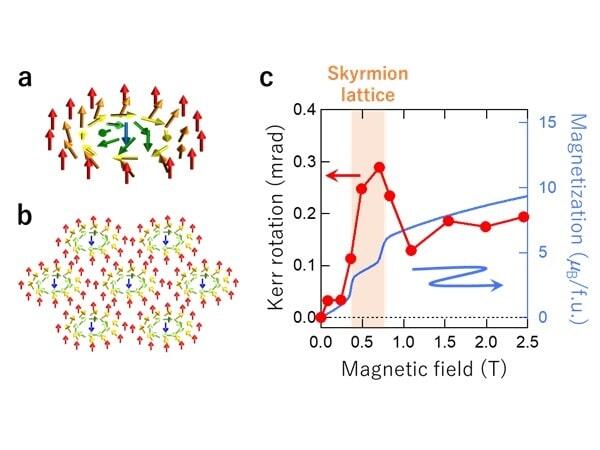Skyrmions possess vortex structures of nanometer-sized spins, with each vortex exhibiting the properties of a particle. These particles function as a single bit and are expected to be applicable in next-generation memory devices owing to their high densities and resistances to external-perturbation-induced corruption. However, methods for reading skyrmions are extremely limited, necessitating the development of a rapid and facile reading method.
A research group led by Graduate Student Yoshihiro D. Kato, Assistant Professor Yoshihiro Okamura, Associate Professor Maximilian Hirschberger and Associate Professor Youtarou Takahashi of the School of Engineering at the University of Tokyo, and Director Yoshinori Tokura of the RIKEN Center for Emergent Matter Science (CEMS) successfully observed the 'topological magneto-optical Kerr effect,' wherein skyrmions twist the polarization plane of light. The results have been published in Nature Communications.

(c) Observation of topological magneto-optical effect. Enhanced magneto-optical Kerr effect (rotation of the polarization of light) appears only in the skyrmion lattice phase.
Provided by the University of Tokyo
The research group focused on Gd2PdSi3, a material with a densely aligned skyrmion lattice, to assess the magneto-optical Kerr effect. The magneto-optical Kerr effect is a phenomenon that twists the polarization plane of light, and it is employed as a reading principle for magneto-optical devices. Usually, the magnitude of the torsion angle of the polarization plane of light is proportional to the magnitude of the magnetization of a material.
In the presence of an emergent magnetic field produced by a skyrmion, the polarization plane of light is twisted regardless of the magnitude of the material magnetization. This phenomenon is called the 'topological magneto-optical Kerr effect' and is the principle adopted for reading skyrmions. In fact, in this study, analyses of the magneto-optical Kerr effect in Gd2PdSi3 over a wide range of light frequencies revealed the occurrence of a large twist in the polarization plane with the appearance of a skyrmion. Following this, when a magnetic field was applied to eliminate this skyrmion, the phenomenon disappeared, confirming that the effect was induced by the emergent magnetic field generated by the skyrmion.
In the current study, this topological magneto-optical effect was also observed in the near-infrared region. Given the prevalence of various laser technologies in the near-infrared region, fusion with laser photonics can be expected to facilitate rapid and non-contact skyrmion detection, leading to the future realization of laser-photonics-fused skyrmion devices.
In addition to these applications in skyrmion devices, the results of this study are also important for fundamental science. The magneto-optical Kerr effect is widely employed in spintronics and other fields as a probe to detect the magnetization levels of materials. The topological magneto-optical effect observed in this study is generated by the emergent magnetic field of a skyrmion and is a new magneto-optical phenomenon unrelated to the magnitude of the material's magnetization.
Conventionally, the use of heavy elements with large atomic numbers is considered essential to achieve a large magneto-optical effect; however, by leveraging emergent magnetic fields, large magneto-optical effects may be achieved using relatively inexpensive materials with small atomic numbers.
Journal Information
Publication: Nature Communications
Title: Topological magneto-optical effect from skyrmion lattice
DOI: 10.1038/s41467-023-41203-y
This article has been translated by JST with permission from The Science News Ltd. (https://sci-news.co.jp/). Unauthorized reproduction of the article and photographs is prohibited.




